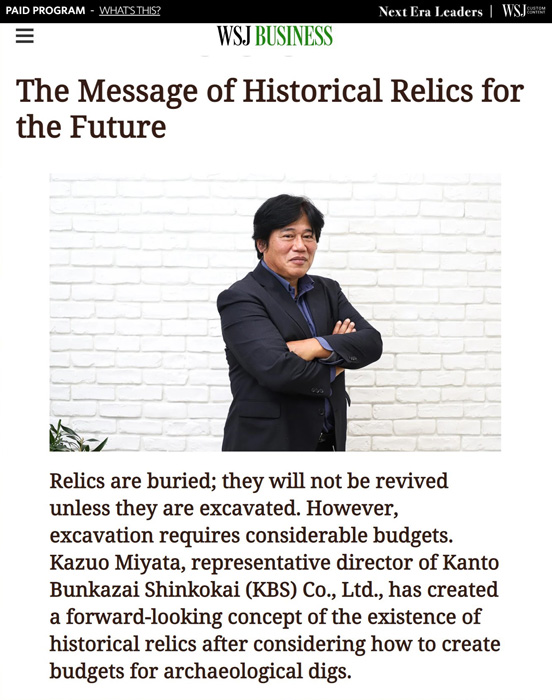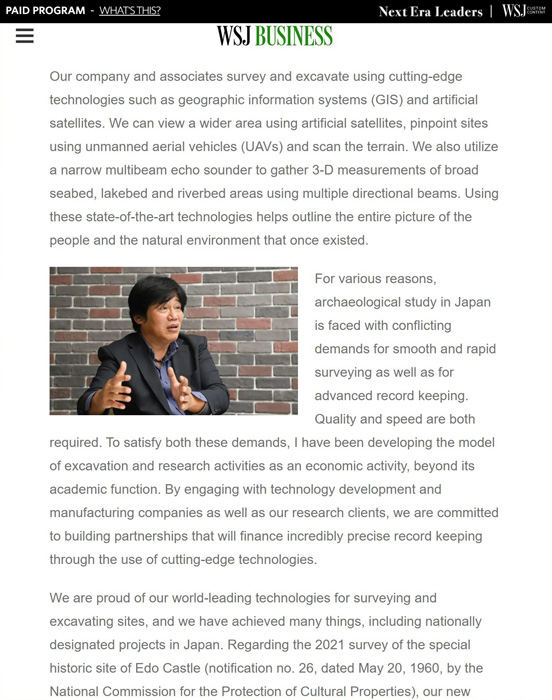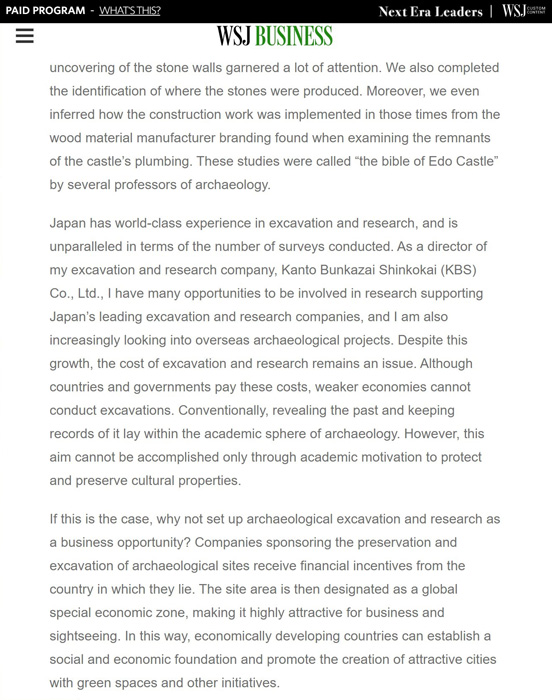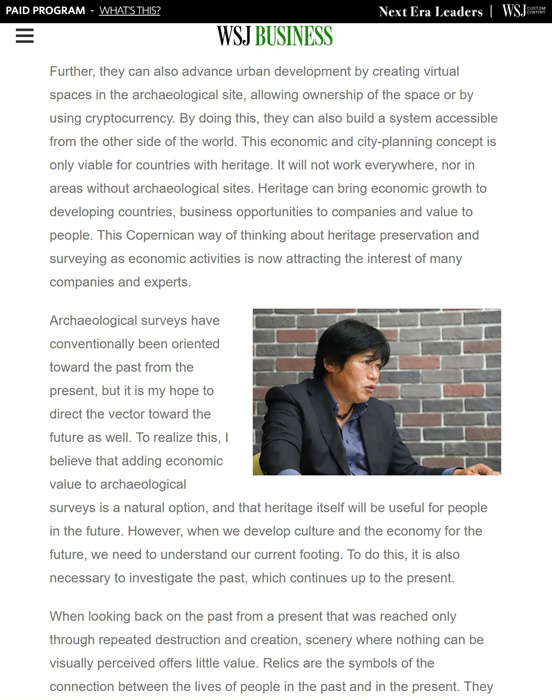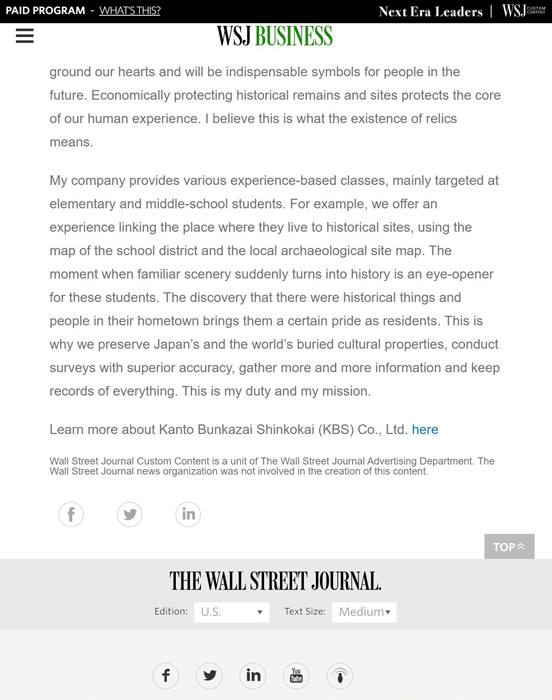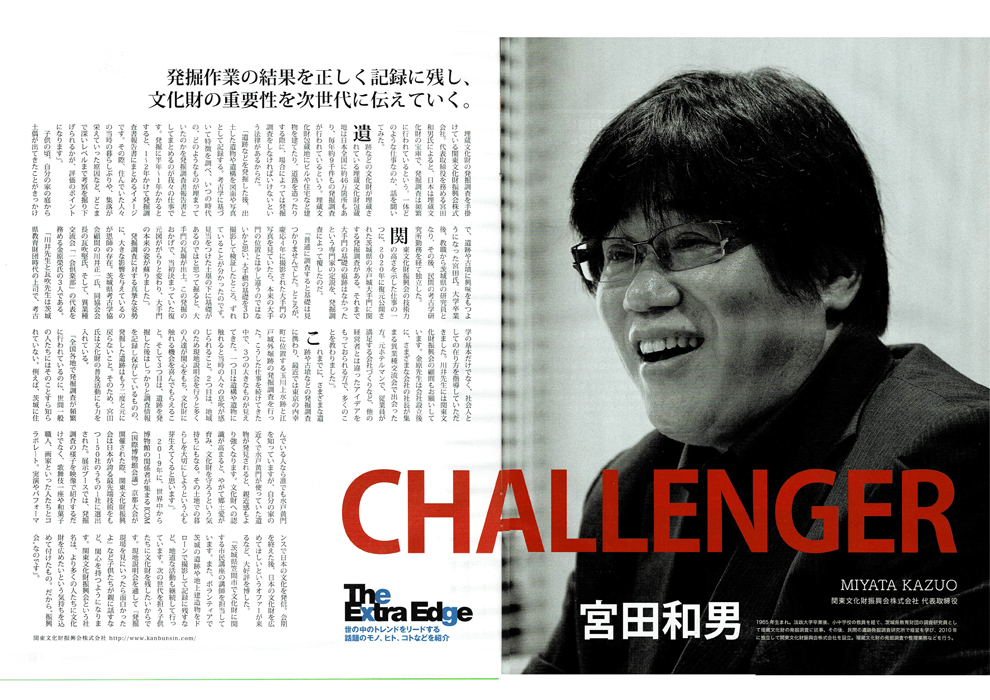NEXT ERA LEADERʼS AWARD
THE WALL STREET JOURNAL
弊社代表取締役 宮田和男が『ウォールストリートジャーナル』(WSJ)が選定する
次世代のリーダー「NEXT ERA LEADERS AWARD」を、
埋蔵文化財発掘調査会社として、世界で初めて受賞しました。
『NEXT ERA LEADERS WSJ』は、画期的なビジネスモデル、クリエイティビティに溢れたプロダクトを引き起こす人として、現在あるいは今後、世界にイノベーションを起こすであろう経営者を特集するメディアです。この企画で特集された世界の錚々たる経営者の中から選ばれたのが「NEXT ERA LEADERʼS AWARD」です。
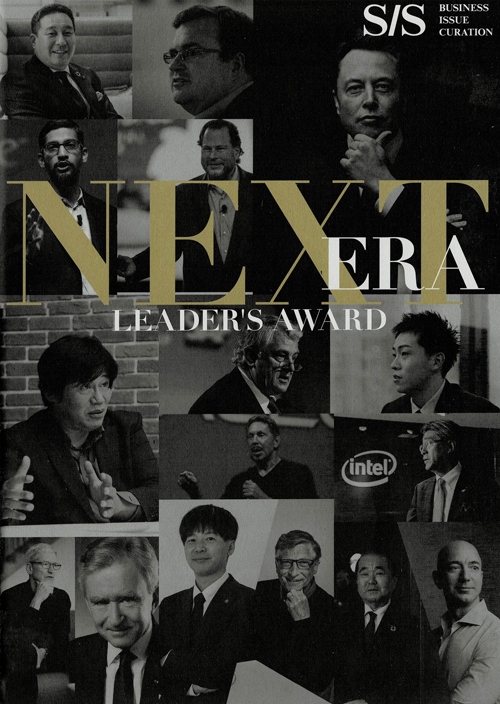 【受賞者(掲載順)】
【受賞者(掲載順)】
Marc Russell Benioff / Salesforce.com, Inc.
Elon Musk / Tesla Motors
Koji Togashi /Global Link
Lawrence Joseph Ellison/Oracle
Timothy Donald Cook / Apple Inc.
Kazuo Miyata/Kanto Bunkazai1 Shinkoukai
Bill Gates/Microsoft
Yuji Shimizu / YZ Consulting
Kunimasa Suzuki / Intel Japan
Bernard Jean Etienne Arnault /LVMH
Reid Garrett Hoffman /Linkedln
Sundar Pichai /Google
Hasso Plattner /Plattner
Shohei Kimura /Blue Inc.
Jeff Bezos / Amazon.com, Inc.
THE WALL STREET JOURNAL
Newsweek
Newsweekに掲載されました(2021.1.26)
The Future Created by the Interrelationship between Archaeological Protection Activities and the Metaverse Business
Current Status of Archaeological Protection Activities
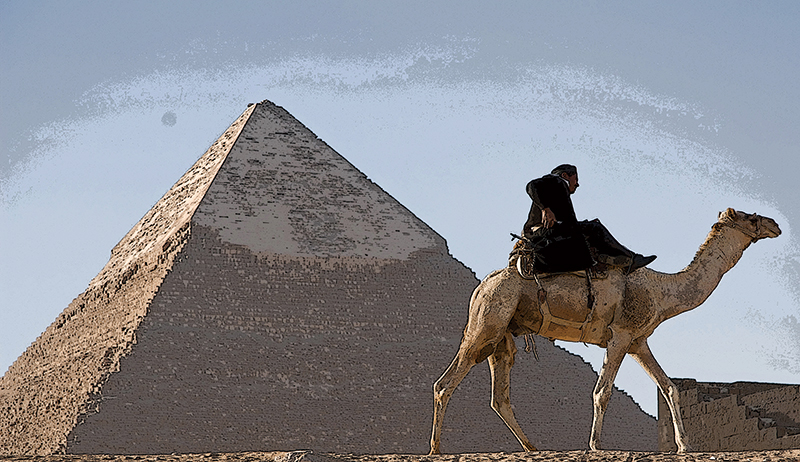
Since UNESCO began registering sites as “World Heritage” in 1975, the idea of protecting and preserving historical heritage on a global scale has been spreading. The number of the sites designated as World Heritage was 1154 in 2021. It is wonderful that we are working to preserve the evidence of our lives. However, if we are asked whether archaeological protection activities are sufficiently carried out, the answer is no. The current problems can be summarized in the following two points.
【1】The number of applications for World Heritage Sites is large in developed countries, but developing countries are more reluctant to designate World Heritage Sites.
(Although cultural heritage protection activities, including archaeological surveys, are actively pursued in developed countries, less so in developing countries.)
【2】World Heritage designation often hinders economic development.
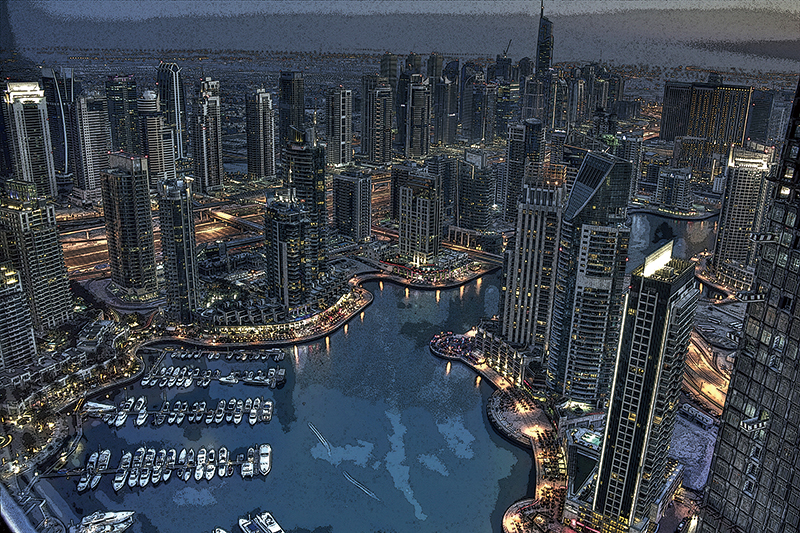 The causes of each of these problems can be considered as follows:
As for 1, it can be said that it all comes down to the issue of financial capability. Archaeological protection activities require not only the obligatory contributions imposed on the States Parties to the World Heritage Convention but also the national budget, which tends to be difficult from the viewpoint of developing countries. Rather than reluctance, the motivation to "protect and preserve cultural properties" is too weak to generate the necessary funds for surveys from the national budget. There are many issues to be tackled by developing countries, and the challenges are cumulative, such as employment issues, education, and provision of medical care. It is natural that the protection of the people is a higher priority issue than archaeological protection. Next, as for 2, many developing countries are eagerly carrying out public projects involving land development with the cooperation of foreign countries, such as providing housing for their citizens and attracting foreign companies’ factories.. However, in order to do so, a vast amount of land is needed, but in many cases, many archaeological sites are located in the target land. If archaeological protection is given priority, the problem of stopping development will occur. In order to protect archaeological sites, funds are needed, but few countries or companies will fund "sites that do not generate money.” The above is a brief overview of the world situation surrounding archaeological protection activities.
The causes of each of these problems can be considered as follows:
As for 1, it can be said that it all comes down to the issue of financial capability. Archaeological protection activities require not only the obligatory contributions imposed on the States Parties to the World Heritage Convention but also the national budget, which tends to be difficult from the viewpoint of developing countries. Rather than reluctance, the motivation to "protect and preserve cultural properties" is too weak to generate the necessary funds for surveys from the national budget. There are many issues to be tackled by developing countries, and the challenges are cumulative, such as employment issues, education, and provision of medical care. It is natural that the protection of the people is a higher priority issue than archaeological protection. Next, as for 2, many developing countries are eagerly carrying out public projects involving land development with the cooperation of foreign countries, such as providing housing for their citizens and attracting foreign companies’ factories.. However, in order to do so, a vast amount of land is needed, but in many cases, many archaeological sites are located in the target land. If archaeological protection is given priority, the problem of stopping development will occur. In order to protect archaeological sites, funds are needed, but few countries or companies will fund "sites that do not generate money.” The above is a brief overview of the world situation surrounding archaeological protection activities.
To Add Economic Value to Archaeological Protection Activities...
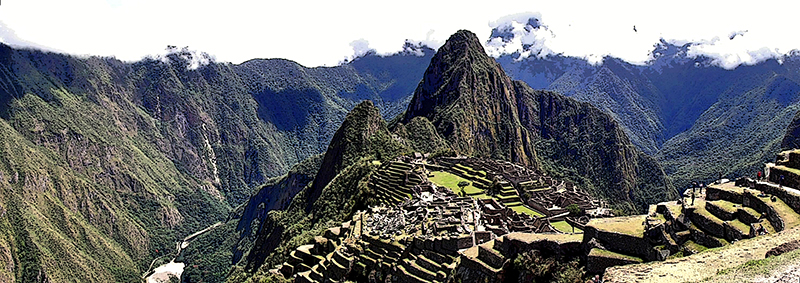
What does it mean to bring economic added value to archaeological protection activities? It means to change from “sites that do not generate money" to “sites that generate money". Countries and companies invest a lot of money in what they see as business opportunities. However, current archaeological protection activities are limited to tourism of the sites at best. We have to change from "sites that do not generate money" to "sites that generate money.” In order to do so, we need to motivate the economy to promote protection activities. As mentioned at the beginning of this article, when we look back at economic history, we can say that people looked toward the future and gathered to create a new society, sharing wisdom and money to drive the economy. When we apply the idea that people and money tend to gather for future-oriented topics to archaeological protection activities, it would be nice to find the "significance of the existence of historical heritage sites" in the orbit of the future-oriented economic cycle. However, the theme of archaeological protection and the economy has been discussed many times, and it has not been successful. Therefore, I would like to make a proposal of my own.
Proposal for Archaeological Protection
-
The country will designate areas including archaeological sites as global special economic zones. (SEZ)
This global special economic zone has two model societies, one with real space and one with virtual space.
Its interchangeability will also create an aggregation place for various kinds of business and tourism. The country requires foreign companies to pay the full cost of the archaeological protection and survey.
In return, the companies get a guarantee that they will be able to
receive a great deal of financial incentives in that country.As a result, the country can lay the foundation for a new economy and at the same time
constitute a cycle that can return profits to the people.Several new special economic zones will be created around the world.
Economic and cultural exchanges between SEZs will be created and deeply connected.
As a result, both real space and virtual space will develop and become richer.
There has been an idea of having companies intervene in archaeological protection for a long time. Therefore, I am sure that there are many people who will laugh at my proposal, saying that it is an idealistic idea that has been discussed and abandoned many times. However, the relationship between archaeological protection activities and the economy has so far only been done in the direction from the present to the past. Of course, there were some people who strongly said that they should direct the vector to the future as well, but they could not find a way to do so within the existing economic framework. Now, however, by bringing in a new economic added value to archaeological protection activities, "creation of a society coexisting with the Metaverse," I believe that it is a new means to help people living in the future.
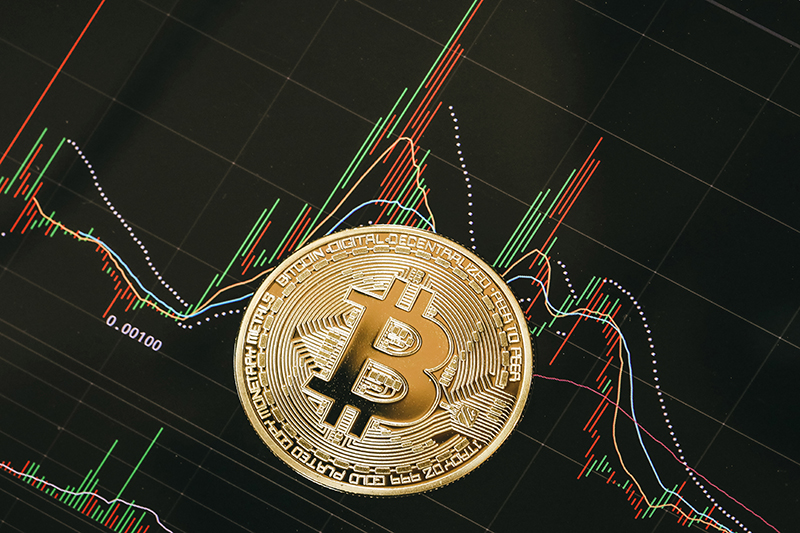 At this point, you may hear people say, "It's impossible to combine historical heritage sites with a virtual space (Metaverse). However, I believe that this dream will become a reality in the near future. Because the framework of the economy itself will be based on the Metaverse . For example, the total market value of virtual currencies used for transactions within the Metaverse alone has now reached $ 3 trillion scale. In the past year alone (2021), El Salvador has recognized Bitcoin as a legal tender, and Sao Paulo, Brazil has announced that it will give preferential treatment to taxpayers who pay their taxes in virtual currency. Moreover, even banks, which were previously thought to be in conflict with virtual currencies, have become more supportive of virtual currencies.
As you can see, Bitcoin (BTC), Ethereum (ETH) and other cryptocurrencies (virtual currencies) have expanded their market size over the past decade. There are even predictions that there will be several countries, especially in South America, that will make Bitcoin their legal tender. Next, I would like to talk about some aspects of the virtual space (Metaverse).
At this point, you may hear people say, "It's impossible to combine historical heritage sites with a virtual space (Metaverse). However, I believe that this dream will become a reality in the near future. Because the framework of the economy itself will be based on the Metaverse . For example, the total market value of virtual currencies used for transactions within the Metaverse alone has now reached $ 3 trillion scale. In the past year alone (2021), El Salvador has recognized Bitcoin as a legal tender, and Sao Paulo, Brazil has announced that it will give preferential treatment to taxpayers who pay their taxes in virtual currency. Moreover, even banks, which were previously thought to be in conflict with virtual currencies, have become more supportive of virtual currencies.
As you can see, Bitcoin (BTC), Ethereum (ETH) and other cryptocurrencies (virtual currencies) have expanded their market size over the past decade. There are even predictions that there will be several countries, especially in South America, that will make Bitcoin their legal tender. Next, I would like to talk about some aspects of the virtual space (Metaverse).
The Metaverse is…
It has been thought that the Metaverse only exists in the world of novels, movies and games. However, it has developed among young people now too. Mark Zuckerberg, CEO of Meta Platforms (formerly Facebook), has announced that the company will invest about $10 billion in the Metaverse business in the fiscal year ending December 2021, and that he hopes to increase the amount in the future to create an ideal Metaverse society. The company plans to develop and evolve virtual reality (VR) and augmented reality (AR) technologies greatly to provide a place where people can set up offices in virtual spaces, hold business meetings, attend live performances by musicians, etc., and ambitiously expand related services. (Horizon Worlds, Horizon Workrooms, etc.) Of course, it's not just Meta Platforms (formerly Facebook), but many of the world's most advanced companies are moving into the Metaverse at an incredible rate, and many companies and countries are beginning to see the Metaverse as a business opportunity and enter the market that will be created by the Metaverse. It is said that the global market for the Metaverse will grow from about $47.69 billion in 2020 to $828.95 billion in 2028.
Also, with the advent of the NonFungible Token (NFT), it has become possible to guarantee unique digital items. This has made it possible to buy and sell digital items such as avatars, buildings, and works of art used in the virtual space, as well as to use and distribute digital content, which is expected to become more active in the future. As of September 2021, the market size of the NFT is approximately $14.1 billion. In addition, the digital economy has been playing a central role in the global economy, as evidenced by the fact that NASDAQ, a stock market for venture companies, mainly IT companies, has become a dominant player in the economic world as a stock exchange that influences the global economy. In this way, the Metaverse business will continue to develop, and the companies that contribute to the Metaverse will become mainstream and drive the global economy. The above is a rough outline of the Metaverse as it relates to business. Next, I would like to explain the relationship between the Metaverse and archaeological protection.
The Significance of the Existence of Historical Heritage in the Metaverse.
The Metaverse is seen as one of many new future spaces, and what is this virtual space built upon? In fact, it is not created by ignoring real space at all, but based on our current real space. I think it’s aim is to be richer than the real space physically and psychologically. Paradoxically, if we ignore the real space altogether and create a new Metaverse as a utopia, I think people who join this Metaverse for the first time will decide to participate based on freedom or inconvenience, loss or gain. This is natural, since they have the motivation to participate in a new Metaverse. That's why, once they feel inconvenienced, they go back to their home, the real space. They have no use for it anymore. My proposal for an ideal Metaverse would include not only the aforementioned sense of freedom and value, but also an element of attachment to the Metaverse itself, such as "love of home.”
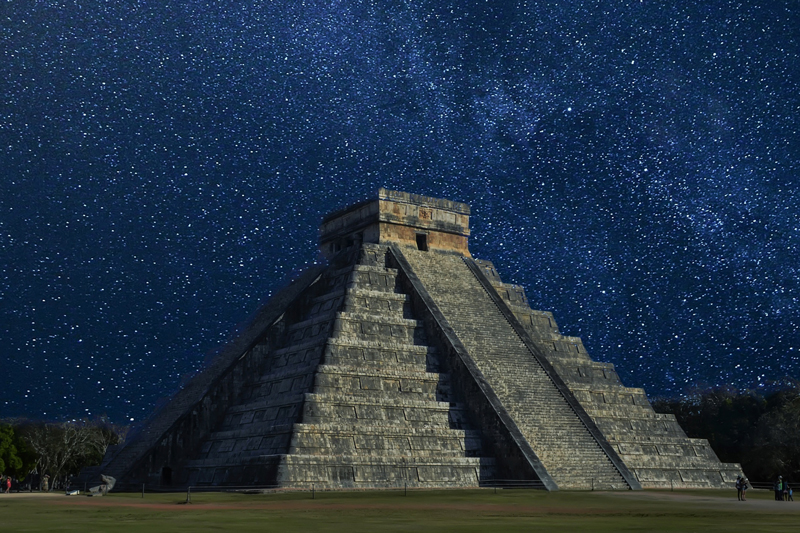 I talk about Egypt as an example so that you can have a better image of my idea. In Egypt, there are many ancient civilizations lying underground. The cost to do archaeological surveys of these sites is enormous, and not only Egypt, but also many other countries that have provided financial support for the surveys. As a result, the country has been earning a lot of foreign currency as a tourist destination. But can we say that Egypt has become an economic powerhouse as a result? Egypt is a wonderful country, but economically, its real GDP is the 32nd largest in the world, and its real GDP per capita is 132nd.
I talk about Egypt as an example so that you can have a better image of my idea. In Egypt, there are many ancient civilizations lying underground. The cost to do archaeological surveys of these sites is enormous, and not only Egypt, but also many other countries that have provided financial support for the surveys. As a result, the country has been earning a lot of foreign currency as a tourist destination. But can we say that Egypt has become an economic powerhouse as a result? Egypt is a wonderful country, but economically, its real GDP is the 32nd largest in the world, and its real GDP per capita is 132nd.
However, if Egypt creates a global special economic zone as mentioned above, and many companies that have invested in the archaeological protection activities in Egypt benefit from the national economic incentives and cooperate in the creation of a Metaverse city, the situation may be changed completely. Incidentally, I would like to use the nickname "Meta-Egypt" for the Metaverse city set in Egypt.
The companies that receive economic incentives from the country will naturally start various businesses within Meta-Egypt. For example, a company that owns a piece of land in the Metaverse can build a virtual building and trade and sell crude oil, gold, etc. inside the building, while medical examinations are held in hospitals, lectures are held in universities, and reading is available in libraries. This is how 'real' life activities can be carried out in virtual space. Moreover, as business flourishes, more and more jobs will naturally be created. The employees will be able to access the system from the other side of the world. Your avatar will come to work in Meta-Egypt's virtual office and join your colleagues who live far away from you. Such a day will come to Meta-Egypt. As a result, business opportunities and networks that have been biased toward big cities will be equally available to people living in rural areas, which could create more opportunities. In addition, by starting a digital twin space (a technology that reproduces real-world buildings in a digital virtual space), it may become possible to own pyramids, install new sphinxes, and buy and sell them in the Metaverse that are impossible in the real world.

As for Egypt, the establishment of Meta-Egypt is expected to bring in corporate investment, huge tax revenue, and income from the NFT related to the historical heritage sites. The proceeds will not only reduce the cost of archaeological protection activities, but will also cover the cost of establishing a special economic zone. In addition, the public funds that have been allocated to the archaeological surveys will be able for allocation to the maintenance of infrastructure such as public facilities and greening activities. It will increase employment there as well.
In addition, tourism in the real world will become even more prevalent than it is now. This is because we can assume that more and more people will want to actually visit the places they are familiar with in Meta-Egypt.
In this way, by linking real society with the future Metaverse society using historical heritage sites as a symbol, the existence of comparative objects enhances the synergistic effect. At the same time, not only the Egyptian but also those who are interested in these sites in Egypt will feel more attached to Meta-Egypt than to the Metaverse cities that are based on unknown motifs. For them, Meta-Egypt is not a new space that is irrelevant to them, but "another space that exists in the sites they know. This is the essential element for the Metaverse business, and I think that it is a concept of urban development based on the digital economy.
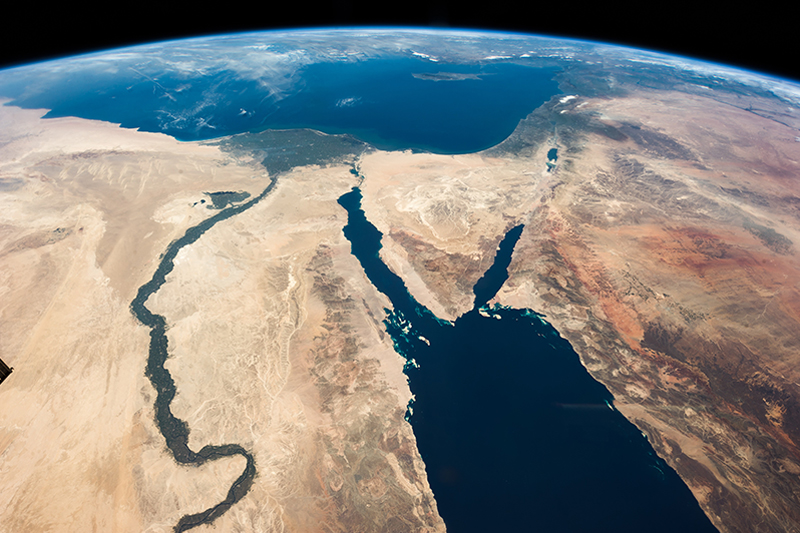 As mentioned above, I have used Egypt as an example, but I believe that it is important to tie up archaeological protection with the Metaverse business in Eurasia, Africa, and other regions. This is because a historical heritage site can be a spiritual home and a symbol for the Metaverse. In other words, archaeological protection is to recreate the layer of the past and link it with a new layer. In this way, the past where the historical heritage sites existed, the real space and the virtual space are fused together.
As mentioned above, I have used Egypt as an example, but I believe that it is important to tie up archaeological protection with the Metaverse business in Eurasia, Africa, and other regions. This is because a historical heritage site can be a spiritual home and a symbol for the Metaverse. In other words, archaeological protection is to recreate the layer of the past and link it with a new layer. In this way, the past where the historical heritage sites existed, the real space and the virtual space are fused together.
To put it simply, archaeological protection activities bring economic benefits to developing countries, and business opportunities to companies. As a result people and the historical heritage sites are connected with a high value in the society, which is Utopia - Metaverse I believe.
What Our Company with The World's Most Advanced Technology Aims for.
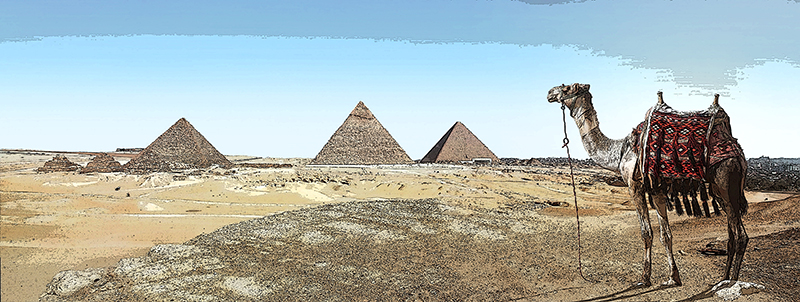
Our company and associates have teamed up many times and undertaken archaeological surveys of various sites. We are proud to say that our excavation technology is one of the best in the world. We have used GIS for the excavation of archaeological sites for many years to visualize information, understand the relationship between information, integrate and analyze information, and create data. We have advanced technologies such as 3D topographic data measurement using artificial satellites and unmanned aerial vehicles (UAVs), 3D underwater topography (bottom of the water) data measurement using narrow multibeam bathymetry and aerial laser bathymetry. We can also provide and analyze optical images and radar (SAR) images using earth observation satellites. These latest technological surveys illuminate the environment of ancient people in an enveloping way. As a result of our painstaking and persevering surveys, we are proud to say that our archaeological survey technologies are among the best in the world, and we have achieved many results, including surveys of nationally designated archaeological sites. In the future, we would like to make more efforts to contribute to archaeological protection than ever before.
Last but not least, if there are any countries or companies that agree with our concept of archaeological protection activities, please contact us by e-mail. We are looking forward to hearing from you.

遺跡保存活動とメタバース事業の相互関係が生み出す未来
遺跡保存活動の現状
1975年にユネスコが「世界遺産」登録を開始して以降、遺跡を世界規模で保護・保存していこうとする理念が広まりつつあり、今や指定された「世界遺産」は、2021年時点で1154件に達します。この、我々の生きた証を残し保存していこうという理念は素晴らしいものと言えます。しかし、遺跡保存活動が十分に行われているかと問われれば、答えはまだまだNO!なのです。その理由(問題点)の多くは以下の2点に集約されます。
【1】先進国では世界遺産の申請数は多いが、発展途上国の多くは世界遺産指定に後ろ向きである。
(遺跡の発掘調査を初めとする文化財保存活動は、先進国で活発に取り組まれてはいるが、発展途上国では比較的少ない。)
【2】世界遺産の指定そのものが、経済発展の足枷となっていることが多い。
これらの理由(問題点)については以下のように考えられます。
1については、ひとえに資金力不足の問題に尽きると言えます。遺跡の保存活動を継続していくためには、世界遺産条約の締約国に課される義務的分担金だけでなく、国家予算をも組み込まなければ不可能なため、発展途上国からみれば、荷が重く消極的になりがちです。消極的というより、「文化財を守りましょう・保存しましょう」といった動機付けでだけは、調査に必要な資金を国家予算から捻出する理由付けにはあまりにも弱いためです。それこそ発展途上国が取り組む課題は数多くあり、インフラ整備、雇用問題、教育、医療の場の提供等、課題は累積しています。遺跡の保護より国民の保護が最優先課題なのだから当然といえば当然でしょう。
次に2について述べていきたいと思います。多くの発展途上国は、海外企業の工場誘致、インフラ整備等、土地開発を伴う公共事業を先進国の協力をもとに意欲的に進めています。しかし、開発のために用意した対象地に多くの遺跡が位置していることは多々あり、遺跡の保存を優先とすると開発自体が進められないという問題が発生します。遺産を保存するためには資金が必要となりますが、その資金までも「金を生まない遺跡」に出資する国や企業は少ないのです。その結果、遺跡の保護・保存への取り組みは後回しになってしまうのが現状です。以上が遺跡保存活動を取り巻く世界情勢です。
遺跡保存活動に経済的付加価値を・・・
次に、遺跡保存活動に経済的付加価値をもたらすことについてお話ししたいと思います。遺跡保存活動に経済的付加価値を・・・とはどういうことなのでしょうか。一言で言えば、「経済的価値を伴わない遺跡」を「経済的価値のある遺跡」へとチェンジさせるということなのです。国や企業というものは、ビジネスチャンスとして捉えられる事には多くの資金を投入します。しかし、現在の遺跡保存活動では、せいぜい遺跡を観光化することくらいが精いっぱいなのです。しかし、これからは「経済的価値を伴わない遺跡」から「経済的価値のある遺跡」へとチェンジさせなければなりません。そのためには遺跡保存活動に経済を動かす動機付けが必要なのです。
冒頭で述べた通り、これまでの人類の経済史を振り返れば、人々は未来へ目を向け、新たな社会をつくるべく人が集い、知恵とお金を出し合い、経済を動かしてきたと言えるでしょう。未来志向の話題に対して人とお金が集まりやすいということは経済史を語る上で当然の論理でしょう。それならば遺跡保存発動を、未来志向の経済サイクルの軌道上に「遺跡の存在意義」を見出すことができればよいのです。しかし、遺跡の保存と経済というテーマは、これまで何回となく議論されてきたことではありますが、なかなかうまくいきませんでした。そこで次に私なりの提言をしていきたいと思います。
遺跡保存のための提言
-
国は、遺跡を含むエリアを世界経済特区とする。
この世界経済特区は、現実空間と仮想空間を有する2つのモデル社会を有する。
また、互換作用により、様々なビジネスや観光の集約地を構築する。 -
国家は、遺跡の保存や発掘調査の費用の全額を海外の企業に求める。
-
企業は、その見返りにその国の金融優遇措置を大いに受けられる保証を得る。
-
その結果、国家は新たな経済の礎を築くと同時に、利益を国民へと還元できるサイクルを構築できる。
-
新しい経済特区が世界中でいくつか生まれる。
-
経済特区間の経済的・文化的交流が生まれ、互いに深く繋がっていく。
-
その結果、現実空間と仮想空間がともに発展し豊かになっていく。
遺跡保存に企業を介在させるという発想は昔からあります。ですので、私の提言に対して、「何度も議論をされてきた上で断念してきた理想論だよ」と笑う方々も大勢いることでしょう。しかし、これまでの遺跡保存活動と経済との関係性は、現在から過去へとベクトルを向けてきただけだったのです。もちろん、未来へもベクトルを向けるべきだと強く発言していた方々もいらっしゃいましたが、既存の経済の枠組みの中ではどうしてもその手立てが浮かばなかったのです。しかし今、遺跡保存活動に対し新たな経済的付加価値である「メタバースとの共存社会の創造」を持ち込むことにより、未来を生きる人たちの役に立つ新たな手段がここに誕生したと考えても良いのではないでしょうか。
ここでみなさんから、「遺跡と仮想空間(メタバース)との組み合わせなんてあり得ないよ」という声が聞こえてきそうです。しかし近い将来、この夢物語が現実になるものと私は考えています。なぜなら、ここでの経済の枠組み自体がメタバース(仮想空間)を主眼に置いているからです。メタバース内での取引に使用される仮想経済を例にしますと、仮想通貨の時価総額だけでも今や3兆ドル規模に達しています。また、この1年間(2021年)だけでも、エルサルバトルがビットコインを法定通貨として認定し、ブラジルのサンパウロでは仮想通貨での納税者への優遇処置を行うと発表しています。しかも、これまで仮想通貨と相反すると考えられていた銀行でさえも仮想通貨に対して協力的な態度へと変貌しているのです。
このように、ビットコイン(BTC)やイーサリアム(ETH)をはじめとする暗号資産(仮想通貨)は、過去10年でその市場規模を拡大させてきました。今後もビットコインを一国の法定通貨とする国が南米を中心にいくつか現れるとの予想もあるほどです。では次に、仮想空間(メタバース)についていくつかお話させていただきます。
メタバースとは・・・
これまで小説や映画、ゲームの世界の中だけだと思われていたメタバースは、今や若者を中心に発展し、「メタ・プラットフォームズ(旧フェイスブック)」のCEOであるマーク・ザッカーバーグ氏は、2021年12月期にメタバース事業に約100億ドル(約1兆1000億円)を投じ、今後更にその額を増やしていき、理想的なメタバース社会を作り上げたいと発表しました。これまでの仮想現実(VR)や拡張現実(AR)技術を大きく発展・進化させ、仮想空間内でオフィスを構え商談を行ったりミュージシャンのライブに参加したりできる場を提供し、関連サービスも意欲的に拡充していきたい考えのようです。(「Horizon Worlds」、「Horizon Workrooms」等参照)
もちろん、「メタ・プラットフォームズ(旧フェイスブック)」だけに限らず、メタバースに対して凄い勢いで世界最先端企業が動いている今、メタバース=ビジネスチャンスと捉え、メタバースから生まれるマーケットに多くの企業や国が参入し始めています。メタバースの世界市場規模は2020年に476.9億ドルほどだったものが、2028年には8,289.5億ドルに達するまでに成長するとも言われています。
またNFTと言われるノンファンジブル・トークン(NonFungible Token)の登場により、唯一無二のデジタルアイテムの保証が可能となりました。それにより、仮想空間内で利用するアバター、建物、美術品などのデジタルアイテムの売買、デジタルコンテンツの利用や流通が可能となったことで、今後はより活性化していくものと考えられています。ちなみに、NFTの市場規模は2021年9月時点で約141億ドルとなっています。また、IT企業を中心とするベンチャー企業向けの株式市場であるナスダックは、世界経済を左右する証券取引として経済界に君臨する存在となっているなど、デジタル経済が世界経済の中心的役割を担おうとしています。このように、今後ますますメタバース事業は発展し、メタバースに寄与した企業が主流となって世界経済を牽引していくことでしょう。
以上がメタバース事業関連の大まかな概略です。次にメタバースと遺跡保存との関係性について述べていきましょう。
メタバースにおける遺跡の存在意義
メタバースは新しい未来空間のひとつとして捉えられていますが、この仮想空間は何をもとに構築されているのでしょうか?実は、現実空間をまったく無視して創造している訳ではなく、現在の私たちの現実空間をもとにしているのです。そして現実空間を物理的にも心理的にもより豊かにしたものを目指していると思います。逆説的に考えれば、現実空間をまったく無視し新たなメタバースを理想郷とした場合、このメタバースに初めて参加する人々は、自由か不自由か、あるいは損か得かで参加を判断しがちだと思います。新しくメタバースに参加してみたいという動機がそこにあるのですから当然のことでしょう。だからこそ、一旦不自由さを感じれば彼たちは故郷である現実空間へと戻ってしまいます。もう用がないからです。私の提案する理想的なメタバースとは、前述したような自由やお得感を感じられることのほかに、メタバースそのものに「故郷愛」のような愛着を感じられる要素を取り入れたものにしたいと考えています。
それでは、みなさんに少しイメージして頂きたいので、エジプトを例にお話ししていきましょう。
エジプトには多くの古代文明遺産が地下に眠っています。これらの発掘調査には莫大な費用がかかり、エジプト国のみならず、多くの国家が資金援助をして調査を行っています。その結果、観光地として外貨をかなり稼いできておりますが、その結果、エジプト国家は経済大国になったと言い切れるでしょううか。エジプト国は素晴らしい国ですが、経済的には実質GDPでは世界第32位で、一人当たりの実質GDPは132位なのです。
しかし、エジプトが前述したような世界経済特区を作り、エジプト国内の遺跡保存活動に出資した多くの企業が国家の経済優遇措置の恩恵を受け、メタバース都市づくりに協力した場合を想定すると、ガラリと様相が変わる可能性があります。ちなみにここでは、エジプトを舞台にしたメタバース都市をメタ・エジプトという愛称で呼称したいと思います。国家の経済優遇措置を受けた企業は、当然ながらメタ・エジプト内で様々なビジネスを始めます。例えば、メタバース内の土地を所有した企業が仮想ビルを建設し、そのビル内で原油や金等の取引や販売を行い、病院では診察等が行われ、大学では講義が、図書館では読書ができます。バーチャル内で`リアル´な生活活動が行われるのです。しかもビジネスが盛んになれば、当然多くの雇用が生まれます。被雇用者は地球の反対側からもアクセス可能な仕組みで在宅勤務が可能です。自分のアバター(分身)がメタ・エジプトのバーチャルオフィスに出社し、遠く離れた土地に住む同僚と一緒に働く。そんな日がメタ・エジプトに来るようになります。その結果、大都市に偏っていたビジネスチャンスやネットワークが地方に住む人々にも平等に提供されることで、より多くのチャンスを生み出す可能性があるのです。また、現実空間内での建物をそのまま再現した、デジタルツイン(現実世界の建築物などをデジタル仮想空間内で再現する技術)なスペースを提供することによって現実世界ではありえないピラミッドの所有や新たなスフィンクスの設置、売買などもメタバース内では可能になるかもしれないのです。
エジプト国家としても、メタ・エジプトの創設により、企業の出資や莫大な税収、遺跡等に関わるNFTの収入等が見込めることになります。その収益によって遺跡保存活動の経費の削減だけでなく、経済特区創設に関わる費用が賄え、しかも、今まで遺跡の発掘調査に振り向けられてきた公的資金が公共施設などのインフラの整備や緑化活動費に振り分けできるようになり、そこでも雇用贈が見込めることになるのです。
なお、現実空間では観光化が今以上に進むことでしょう。なぜなら、メタ・エジプトで馴染みある場所を現実空間内でも実際に訪れてみたいと思う人々が増えることは十分想定できるからです。
このように、遺跡をシンボルとした現実社会と未来のメタバース社会がリンクすることによって、比較対象が存在し合い相乗効果を高めるのです。それと同時に、エジプト国民だけでなく、エジプトの遺跡に関心を持っている人々は、何をモチーフにしているのか分からないメタバース都市よりもメタ・エジプトに対し、多くの愛着を感じてくれることでしょう。彼らにとっては、メタ・エジプトは自分にとって関係のない新しい空間ではなく、「私たちの知っている遺跡に存在する別空間」なのです。これこそがメタバース事業にとって欠かせない要素であり、デジタル経済を基にした街づくりの理想的構想に成り得ると考えています。
以上、ここではエジプトを例として挙げましたが、ユーラシア大陸でもアフリカ大陸でもその他の地域でも、メタバース事業に遺跡保存活動をタイアップさせることは重要ポイントになると考えます。メタバースにとって、遺跡は心の拠り所でありシンボルにも成り得るからです。言い換えれば、遺跡の保存とは過去というレイヤーを創造し直し、新しいレイヤーとリンクさせることだとも言えると考えます。そうすることにより、遺跡が存在した歴史(過去)と現実空間(現在)と仮想空間(未来)を融合させるのです。
結論を端的に表現すれば、遺跡の保存活動を通して、経済発展途上国には経済を、企業にはビジネスチャンスをもたらし、その結果、人々と遺跡が価値高く繋がる社会であり、それこそが理想郷=メタバースであると思うのです。
最後になりますが、弊社の遺跡保存活動への考え方に賛同して頂ける方や法人様がいらっしゃいましたら、ぜひメールにてご連絡ください。お待ちしております。



